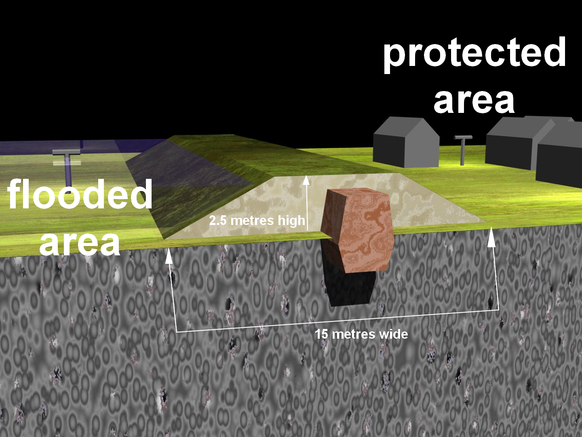Retiring Embankments for Flood Control |Manohar Khushalani

Embankments:
They may be defined as earthen banks extending generally parallel to the river channel and designed to protect the area behind them from overflow by flood water. The choice, the location the alignment, the type, the shape, and the size of the embankment depend upon the flood, the protected area, the economics, and the after effect of such protective structures. There are three major types of Embankments:
Marginal Embankment: They are constructed along both sides of a river upstream of a barrage or weir at a short distance from the margin.
Approach Embankment: It is the embankment that is provided to approach the barrage or weir from the high river edges on the both sides.
Retired Embankment: They are constructed at a distance from the river edge behind the existing embankment as a second line of defense. When Retired Embankments are constructed along both sides on high ground, sufficiently away from the river bank, more or less straight and little away from river channel to minimize the risk, they are sometimes called Flood Embankments. This is a very effective system and a neat solution to Flood Control where conventional methods of providing closer embankments are not effective. The following is an excerpt from our Book,
Irrigation Practice & Design Vol I by K. B. Khushalani & Manohar Khushalani (Published by Oxford & IBH and sponsored by National Book Trust)
12-6. System of Retiring Embankments. The retiring embankments are a via media between no embankments and very close embankments. They are constructed at a distance from the river.
The advantages of the retiring embankments are:
(i) They cause lesser interference with the natural operation of silt deposited by the river over the country and raising its level.
(ii) They enable the river flood to be spread over more area, thus creating an artificial storage. This storage is not the storage in the ordinary sense but storage due to the detention of Water for some period. This reservoir capacity enables the river to maintain a fair irrigating level for a longer time, and hence can be utilised in giving water to inundation canals.
(iii) By providing a wider waterway they enable the high flood water level to be lower than would be the case with closer banks and thus, they reduce chances of erosion of fertile land and throwing up of sterile sand banks.
(iv) The banks being away from the river are not so frequently attacked as would be the banks near the river edge.
(v) The longer life thus bestowed on the embankments permits of their being constructed slowly and carefully and much in advance of time when they will be required to face the flood. Enough opportunity is thus given to these embankments for settlement and consolidation.
(vi) The longer life, on account of creating the sense of security, which is essential for progress and prosperity, provides greater permanence to the irrigation investments.
The disadvantages of the retiring embankments are:
(i) Increased cost, as they are to be sometimes constructed on lower ground. The cost is more in the beginning, but if frequent damages to the closer banks are taken into account the ultimate cost will be less.
(ii) They afford protection to lesser area than do the closer banks.
The area between the river and the embankments will grow some inundation crops after floods or even forests can be grown on them. Thus the loss can be reduced.
(iii) They require longer length of open canal heads which get silted. This is a serious objection and has to be tolerated in view of so many advantages and can be remedied by constructing an escape upstream of the head regulator to scour out the silt.
(iv) On account of their being constructed on lower grounds they are risky. The land generally slopes away from the river and as the banks are to be constructed further away their height will be great. A bank of higher height is naturally prone to be more dangerous than a bank of smaller height. Though this is true, water could be led in by the side of a bank for soaking: As the bank is on a lower ground this should be possible.
All the flood control methods are not to be considered as separate solutions of flood problems; often two or more of them would be necessary to tackle a particular stream. Where it is, found that combination is eventually the correct solution, the extent to which the various components should be used, can be determined by striking an economical mean
Retiring Embankment has been used in India For eg. Mr. M . Zonneveld, an expert from Holland after rigorous survey in Sundarban put forwarded the suggestion of building ‘retiring’ embankment at considerable distance from from the existing one1. I quote “The embankment should be built as far away from the main river as possible to minimize the impact of the dashing waves. This proposal can be introduced in the Ghoramara Mouza under Sagar Island block now facing severe erosional threat where land is consistently being withered away by strong fluvial erosion”.
Retired Embankments have also been used extensively in Farakka Barrage2 and in 1960 it was provided on the 220 Km Brahmaputra Right Bank Embankment (BRE)3,
1 https://shodhganga.inflibnet.ac.in/bitstream/10603/155888/18/18_concluding%20remarks.pdf
2 http://ir.nbu.ac.in/bitstream/123456789/831/13/13%20CHAPTER%206.pdf
3 https://ewsdata.rightsindevelopment.org/files/documents/34/WB-P149734_wP3HlM2.pdf



Retiring embankments are definitely better than the embankments constructed on the banks which cause River jacketed and interfere with the River regime. However sparing of land as required between River and the retiring embankments is an issue where people encroach every inch of land to construct buildings and farms.